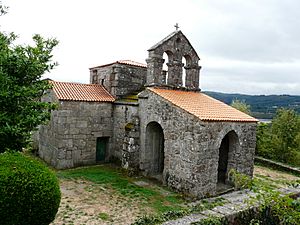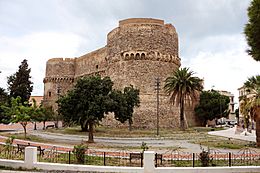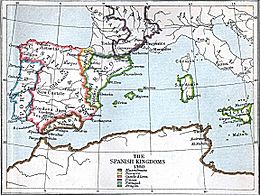Spain in the Middle Ages facts for kids
The Middle Ages in Spain was a long period in the history of Spain. It started in the 5th century, after the fall of the Roman Empire, and ended in 1492, when the modern age began.
Spain's history during this time was shaped by different groups of people who came and brought their own cultures. First, the Vandals and Alans arrived in 408. Then, the Visigoths, who were Arian Christians, formed a kingdom from 507 to 711. Their king, Reccared, became a Catholic in 587, and many Visigoths followed.
In 711, Muslim armies from North Africa, led by the Umayyad Caliphate, crossed into Spain. They were invited by a Visigothic group to help them against their king, Roderic. Between 711 and 788, the Umayyads conquered most of the Visigothic kingdom. This new Muslim territory was called Al-Andalus. However, a Christian kingdom called Kingdom of Asturias started in the north of Spain during this time.
Much of the Middle Ages in Spain was filled with wars between the Muslim and Christian states. This period is known as the Reconquista, which means "reconquest." Christians believed they were taking back their lands as a religious fight. The border between Muslim and Christian areas moved south over 700 years of war. There were also fights between the different Christian kingdoms and between the Muslim taifas (smaller states that formed after the main Muslim rule). For example, the Crown of Aragon and the Crown of Castile often fought over land or power.
The Middle Ages in Spain is often said to end in 1492. This was when the last part of the Reconquista finished with the surrender of the Nasrid Emirate of Granada. Also in 1492, the Alhambra decree ordered the expulsion of Jewish people from Spain. Spain then became united under one rule, especially during the time of Charles I.
Contents
Early Medieval Spain: Visigoths and New Arrivals
When the Germanic tribes invaded the Roman Empire, different groups came into Spain. These included the Alans, the Vandals, and the Suebians. The Alans were mostly defeated quickly. The Vandals settled in a region they called Vandalusia (now Andalusia) before moving to Africa. The Visigoths pushed the Suebians into Galicia and eventually took control of them.
The Visigoths, who had previously sacked Rome in 410 under Alaric, moved into the northeastern part of Spain with their leader Athaulf. Later, Wallia expanded their rule over most of the peninsula. Theodoric I even fought alongside the Romans and Franks against Attila in the Battle of the Catalaunian Plains.
Euric (who ruled around 466) is seen as the first true king of Spain. He ended the last parts of Roman power in the peninsula. Euric was also the first king to write down laws for the Visigoths. Later, the Catholic kings of France became protectors of the Catholic people in Spain against the Visigoths, who were Arian Christians. This led to wars where Visigothic kings like Alaric II and Amalaric died.
Athanagild rebelled against King Agila and asked the Byzantine Greeks for help. In return, he gave them control of coastal areas in the southeast (554). Liuvigild brought political unity back to Spain by defeating the Suebians. But religious differences, even within the royal family, caused a civil war. His son, St. Hermengild, led the Catholics but was defeated and killed for refusing to join the Arians.
Reccared, Liuvigild's son and St. Hermengild's brother, brought religious unity to Spain. He accepted the Catholic faith in the Third Council of Toledo in 589.
Kings Sisebut and Suintila finished pushing the Byzantines out of Spain. Chindasuinth and Recceswinth worked on creating common laws for everyone. They also made it legal for Goths and Latins to marry, which had been forbidden before. In 711, North African Berber and some Arab soldiers, led by Tariq ibn Ziyad, crossed the Strait of Gibraltar. They fought the Visigothic king Roderic at the Battle of Guadalete. This happened when the Visigothic Kingdom was already facing serious internal problems.
Medieval Islamic Spain: Al-Andalus
After the Muslim conquest, a large part of Spain became known as Al-Andalus. This area was ruled by different Muslim dynasties.
The most important rulers were from the Umayyad family:
- The Umayyad Emirate of Cordoba (756–929)
- The Umayyad Caliphate of Cordoba (929–1031)
After the Caliphate ended, Al-Andalus broke into many smaller Muslim states called Taifa states.
Medieval Christian Spain: The Reconquista
The Christian people who fled from the Muslim conquest found safety in the northern mountains. These mountains were areas where the Romans had never fully taken control. Only a few years after the Battle of Guadalete in 711, the Christians won a victory over Alqama at the Battle of Covadonga (around 718 or 722).
Don Pelayo, a Gothic leader, was hailed as king after the victory at Covadonga. He set up his home in Cangas de Onís. His son, Favila, died while hunting. Then, Alfonso I, Don Pelayo's son-in-law, became king. He expanded the Christian kingdom into Galicia.
Fruela I (727–728) founded the city of Oviedo. Later, Alfonso II, the Chaste, made Oviedo his capital. He started major attacks against the Muslims. He may have even invited Charlemagne to Asturias, which led to Charlemagne's expedition that ended badly at Roncevaux.
The Vikings attacked Galicia in 844 but were driven away by Ramiro I. Seventy Viking ships were captured and burned. Vikings returned in 859, but an army led by Don Pedro defeated them and destroyed 38 of their ships. Alfonso III, the Great, continued to push south and founded Burgos, which later became the capital of Castile. His sons rebelled against him, and he divided his kingdom among them. This marked the end of the Kingdom of Asturias, which soon became part of León.
Another important area for the Reconquista was Aragón. Navarre and Catalonia had closer ties with France because of their history. The Basques, living on both sides of the Western Pyrenees, often rebelled against Frankish rule. At Roncevaux, they destroyed Charlemagne's forces. In 824, another victory secured the independence of the Basques in Pamplona.
Sancho III, the Great, was a very important king. He ruled Navarre, Castile, Aragón, and Sobrarbe. When he died in 1035, he divided his kingdoms among his sons.
How Christian Kingdoms United
It was hard to unite the different Christian states formed during the Reconquista. Navarre and Catalonia had strong connections with France. For example, the marriage of Ramón Berenguer the Great to Dulcia, who was from Provence in France, linked Catalonia more closely to southern France. In Navarre, when the first royal family ended, the crown went to French families, meaning Navarre had closer ties with France than with other Spanish states until the 15th century.
Also, the feudal system, which involved dividing lands, caused kingdoms to be split up many times. For example, Ferdinand I divided his kingdom into five parts. Although his son Sancho the Strong reunited it, Alfonso VII later separated Castile and León again.
The separation of Portugal also happened because of these customs. Alfonso VI gave his daughters in marriage to French nobles, who then founded the royal families of Portugal and Castile and León.
Eventually, the Kingdoms of Asturias, Galicia, León, and Castile were united under Ferdinand III. He inherited León from his father and Castile from his mother. In a similar way, Catalonia and Aragón were united when Ramón Berenguer married Doña Petronila of Aragón.
The kingdom formed by Aragón and Catalonia was the first to finish the Reconquista in their area. Then, they looked eastward. Peter II the Catholic tried to get his marriage canceled and be crowned by the Pope. He failed at the first, and the second caused problems because Aragonese nobles didn't want their kingdom to be a vassal of the Pope. These nobles forced the king to agree to a "union" that gave them more power. Later, Peter IV famously cut up the document that recorded this agreement.
Peter II the Catholic died in the Battle of Muret (1213), defending his relatives against Simon de Montfort. His son, James I, the Conqueror, completed the Catalan-Aragonese Reconquista by taking Majorca (1228) and Valencia (1238). He also helped his son-in-law, Alfonso X, conquer Murcia.
James I's son changed the direction of Aragonese policy by claiming his wife's rights to the kingdoms of Sicily and Naples. Taking advantage of a rebellion against the French (the War of the Sicilian Vespers in 1282), he gained Sicily and attacked Naples. This led to conflicts with the Popes, who supported the French.
Meanwhile, the Reconquista slowed down in Castile. This was partly because Alfonso X tried to become the Holy Roman Emperor. Later, there were disagreements over who should be king. Ferdinand IV became king at age nine, with his mother María de Molina guiding him. Alfonso XI was also very young when he became king. Although his reign was successful, and he defeated the Marinids in the Battle of Río Salado (1340), his personal life led to wars in the next reign.
His son, Pedro the Cruel, was eventually killed by his half-brother, Henry of Trastámara, who became king. John I tried to unite Castile and Portugal by marrying the Portuguese princess Beatrice of Portugal. However, the Portuguese defeated John of Castile at the Battle of Aljubarrota (1385), and Portugal remained separate.
Henry III married Catherine of Lancaster. He was the first to use the title Prince of Asturias for the heir to the throne. He became king as a child, just like his son, John II.
Culture and Daily Life
During the Middle Ages, the history of the Spanish language began. Old Spanish was spoken, and other languages like Catalan (especially the Valencian dialect) and Aragonese also developed their own literature. Languages like Asturian Medieval Spanish, Galician, and Basque were mostly spoken, not written down much.
King Alfonso X was very interested in learning. In 1283, he ordered a translation of an Arabic book about chess and other games called the Libro de los Juegos. This book has over 100 chess problems and different ways to play chess. The king also helped create many music pieces, like the Cantigas d'escarnio e maldicer and the Cantigas de Santa Maria. The Cantigas de Santa Maria has more than 400 poems with music, making it one of the largest collections of songs from the Middle Ages.
Important Cities
Medieval Spain was a network of important cities. These cities were centers for culture, government, and trade. They often had markets, homes, and a strong castle or fortress at their heart. You can follow the history of medieval Spain through these major cities:
|
See also
 In Spanish: Historia medieval de España para niños
In Spanish: Historia medieval de España para niños
- Spanish chivalry
- Medieval Spanish literature




